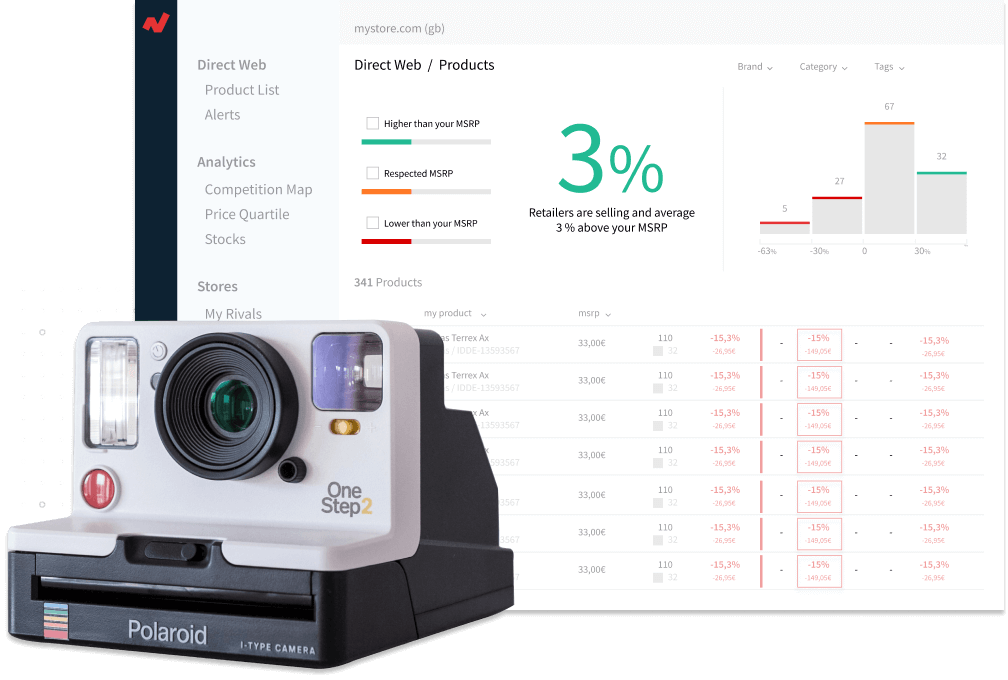How to improve your branding
As a brand, you can act on the way your customers perceive your products by knowing how to improve your branding. Customers nowadays have access to complete and updated information about your brand and products, the reason why transparency should be taken as a crucial element of your marketing mix.
With the evolution of the current sales channels, each time it is necessary to maintain transparent strategies. This should be considered as an advantage and not the contrary, as it gives you the possibility to make your customers perceive the message in the way you want to convey it.
Moreover, the new data management tools offer valuable information about the state of the market. These allow you to learn and improve the results of your business strategy. These tools are as important as the infrastructure and logistics of your brand.
Brand’s reputation in the market
Consumers purchase from different channels, when and where they want. Hence, as a brands it is absolutely necessary to build a reputation as trustworthy and with more merits than your competitors. Consumers must be aware of your achievements, the existence of your brand, its quality and its price, which are all factors that majorly influence their perception and can enhance your brand’s position in a very significative way.
Price, quality and service are key levers to succeed in the current competitive landscape.
Price, quality and service are key levers to succeed in the current competitive landscape. In the majority of cases, clients have the impression that the company that is dedicated to offer value is the one that will offer the most competitive prices.
Value and price go hand in hand. For this reason, and without questioning, any decision in respect to your pricing strategy will have to be justified with a detailed and complete analysis of your competition’s prices, as well as how your own products are distributed by your intermediaries until they reach your final customer.
Competing brands
Several questions arise at this point like how competitors react when facing changes in the market, what the strategies are to differentiate from competitors, as well as when the right time is to increase or decrease prices.
One situation that could conduct to a price reduction would be after collecting data about the market and detecting increasing product demand combined with fierce competition. Another reason for reduction would be aiming to slash the competition’s market share knowing that further reductions on their side would damage their profitability. You need to be careful with price reductions, though, given that a drastic price reduction could harm the image of your products’ quality.
Succeeding is difficult without a way of obtaining detailed information on the market.
In this respect, analytics tools are critical to measure your results and gain competitive advantages by allowing you to detect threats and opportunities in the sector, as well as to maintain or increase your market share.
Although the focus given to pricing is significant, tracking your competitors carries a high importance too. The truth is that succeeding is difficult if you don’t dispose of a special system that will provide detailed information about the market and its evolution, and the reactions from competition. For instance, in cases where demand is difficult to measure, if you are uncertain of whether to reduce costs, including when it is difficult to determine the price for a product in the market, it is useful to know at which price competitors are selling.
Distribution channels
As a brand, you should be concerned about how your products are sold from the first step until the last one: the consumer. The intermediate company holds an important function for brands and manufacturers, since it accelerates the distribution process making some products more accessible to the final customer. In fact, commercial costs are saved on distribution when using an intermediary, because taking care of them would most likely imply increasing prices of products, which in turn would lose competitiveness.
-
Initial product
vision by the brand -
Detailed view on
distribution channels -
Data to influence
product perception
On their side, intermediaries want to be profitable as well. They need to cover their costs to obtain a profit and that is the point where the manufacturer or brand loses the control the price at which products are being sold. When it comes to large manufacturers with a high incidence on the distribution chain, more pressure can be exerted on price, but, if we look at several manufacturers, that possibility diminishes and, in many cases, information about whether these intermediaries respect the prices indicated by the companies is lost.
That is why, it becomes so important for brands to check on their intermediaries and distributors. This analysis can provide them with a more comprehensive view on the image given to the product by customers, their perception in comparison to competitors, as well as better understading how their catalog is sold.
Market analysis tools for KAMs
The KAM (Key Account Manager) is in charge of establishing and maintaining sales relations on the long-term with the most important clients of the company (key accounts). Moreover, the KAM must focus on customer relations and ensure their success.
The KAM’s position is very important in the relationship distributor-customer.
This task is of utmost importance to the company, since this strategic approach of “keeping the customer satisfied” is what will ensure a more personalized service to these large accounts, which in turn could possibly increase sales and profits.
The distribution and sales channels have very much increased in recent times, and they have become something much more complex. The KAM’s function at this point has become very relevant because he is the person who deals directly with the distributors and, therefore, the one who has the most influence on the distribution strategy.
The customers’ satisfaction and an increase in sales are the principal goals of a KAM, supposing the company is already successful. In fact, the role of a KAM has resulted from an increasing and constant search for quality at a competitive price by the buyers.
Online channels are one of the most used in respect to sales nowadays, and its transparency is the aspect that engages consumers to research information for days before making their final decision. For this reason, the KAM has a very important role in the fight towards being the most competitive company on the market. He will be the one to strengthen the relationship between distributors and customers, and get close to those reduced costs that will allow the company to offer more value at a better price.
However, the KAM’s influence depends on whether the company’s product distribution is done in a direct or indirect way.
Direct distribution
The KAM already has data about final customers which enables him to build a solid basis of satisfied customers translating to higher sales and profits.
Indirect distribution
The KAM lacks information about final customers, and will not know if the vendors are respecting the sales prices recommended by the company.
VS
Today, over 70% of the most outstanding companies have a KAM figure, and it is them who have the responsibility to collaborate with the marketing department in the creation of messages destined to the public with different goals; advertising products, assure customer satisfaction, develop and improve business and distribution strategies, develop the product to be certain that costs will allow for a higher value at a more competitive price, as well as deciding the prices of these products, namely to make the relevant pricing decisions.
So how can an analytics tool such as a Price Intelligence Software help improve daily performances and price management tasks of KAMs? In order to gain customers and to retain them, the message of quality and value of their products must be conveyed successfully, but it cannot be omitted that price variable is critical for customers who end up inclining to a product or another one of similar characteristics. Let’s see now how Price Intelligence Software can become a powerful for KAMs.
Benefits from the price analysis platforms for KAMs
Gain in competitiveness
Analytics from Big Data such as those offered by netRivals SaaS provide a detailed view of your competition and the role your company plays in front of it.
Moreover, you can track as many competitors as you want, giving you a unique opportunity to understand the market, its opportunities and threats.
In short, you can advance and develop a strategy that is much more attractive and competitive at the pricing level. A product differentiated by value and quality at a more competitive price will allow you to retain many more customers and, therefore, increase the number of sales.
Product development, marketing and positioning
The goal here is that both loyal customers and potential customers receive the right message about your brand and products. netRivals analytics software gives you a clear view of your product in the market and how it competes with others which share similar characteristics. Thanks to the market analysis, you can make the relevant decisions regarding the development and marketing of the product.
Analyzing the pricing of similar products in the sector you can establish if you want to reduce costs to reach more competitive prices and achieve more focused marketing to a brand dedicated to offer value. This sum of variables will make you achieve a better position in the industry.
Match stock with demand
It is essential that the product is available at the appropriate time and place. Not foreseeing sufficient product demand will cause you to lose sales and fail to achieve your business objectives. And if, on the other hand, you foreplay too much, you end up storing product and losing capital that could have been invested in another objective.
By using netRivals, you can know the stock status of your distributors, which will allow you to know if there is an excess or stock break. This information will be very helpful to you when setting or modifying sales targets.
The distributor-final customer relationship
Another objective is to achieve the success of the brand and its products. However, this will not happen if you don´t have information about what happens to your products on the indirect distribution channels. As a KAM, you have a greater influence on direct distribution channels than on indirect distribution channels.
In the direct distribution, you know firsthand who the final customer is and what their expectations are, which allows you to develop strategic plans to meet such requirements and achieve loyalty. However, in indirect distribution channels, you do not have this information and do not know if sellers respect your suggested sales prices, which could damage your brand from the perspective of the final customer.
Market analysis tools for Product Managers
A Product Manager’s fundamental mission is to look for business opportunities that can be transformed into profitable products. They are in charge of managing the life of these products and carry out the relevant market analysis in order to use the marketing strategies that best fit the situation. Their function does not end with the launch of the product, though. It goes beyond its development and appearance in the market.
One of the peculiarities of the Product Manager is that they work with multiple departments of the company that go from production to sales, so it is not surprising that with the introduction of the product in the market, the mission of the Product Manager extends to other areas.
For example, such as marketing and tracking the evolution of the product, as well as the study of its profitability and performance compared to other competing products with similar characteristics.
Market study before and after product launch is a key factor for the Product Manager.
Data on logistics, production, sales, stock levels, distribution and product performance constitute the fundamental basis in decision making that will have a direct impact on the product and its profitability for the company.
As it can be observed, the tasks of the Product Manager encompass coordination with various departments, thus gathering information on all of the above mentioned areas manually can lead to valuable time and resources for the equipment that could be used for other purposes of the business.
It is for this reason that looking for tools that speed up this task and doing it in an automated way can help optimize the performance of the Product Manager’s decisions and it is precisely the competitive intelligence platforms such as netRivals price tracking software that can help maximize the profitability of such decisions.
Benefits of price analysis platforms for Product Managers
Greater profitability for products
Monitoring and tracking price helps you to find the necessary data needed in order to maximize the benefits of each of your products. The product must reach the desired quality and objectives, but this factor must be added to another one of great relevance, namely the analysis and the negotiation of the price.
The current trend of the consumer is to seek quality at the best price so, if your product can not stand out in terms of differentiation, you must do so in terms of competitiveness. It is the strategies based on the price that will help you gain more market share and customer base.
Gaining in competitiveness and transparency will make the image of your brand improve from the perspective of customers, since it is the price which, in many cases, ends up summarizing the company’s policy. What’s more, it’s the low-cost policies that are capturing more customers today. By automated tracking of competitive prices, you will not only be able to know firsthand what the sector’s pricing trends are, but also maximize your team’s tasks by optimizing time and money.
Improve company’s internal and external areas
On the internal level, the implementation of automatic price management platforms will allow you to optimize the decisions that affect production costs, control the product stock to know whether to produce more or stop at risk of excess stock, as well as improving the relationship quality-price and benefits in general.
As far as external areas are concerned, the tool will give you a broader view of the markets in which your brand operates on the selected products. It will also allow you to track price and promotion fluctuations, detect opportunities or threats in the markets, and know what happens to the sales and distribution channels of the same product in different geographical areas and countries.
To conclude
The decisions you make regarding your pricing affect the image and value which customers perceive of your brand. Moreover, such decisions will not be effective unless they are justified by a careful analysis of the market situation.
For this reason, the tools that facilitate data capture, as well as automated and exhaustive tracking such as netRivals analytical software are essential for improving the branding strategy. The Big Data of netRivals will provide you with the necessary information to maximize your business performance and your results on the market share and image of your brand.
The netRivals price intelligence platform has been specially developed by technicians and pricing experts allowing brands to:
- Obtain data on prices and stock of intermediaries.
- Monitor MAP and product reviews.
- Compare price moves in competing products.
- Get equivalences for competing products.




